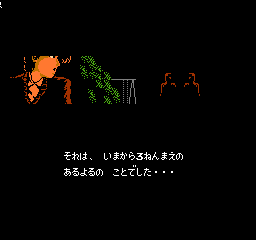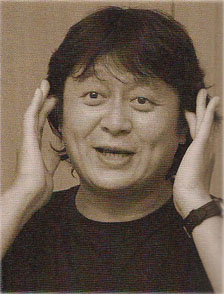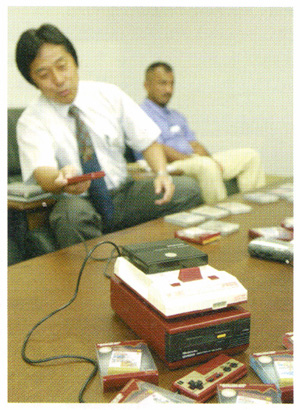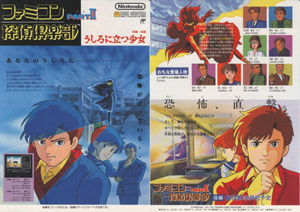Special articles, columns and features exclusive to the MDb.
Famicom Disk System:
The More You Play It, the More You'll Want to Play! [Disk 2]
Introduction | Part 1 | Part 2 | Part 3 | Part 4 | Part 5 | Part 6 | Part 7 | Part 8
OBSESSING OVER THE MUSIC IN THE GIRL WHO STANDS BEHINDAnd now a story about The Girl who Stands Behind. I hope we haven't kept you waiting, Yamamoto-san! Yamamoto-san worked on the sound for this game.Yamamoto: That's right. Of course, I take it there was trouble whittling away data, even with the sound.Yamamoto: There was. For instance, when Part One was read into the system, there was, of course, a mechanism that inserted data into Part Two, but it didn't work very well, and after Part One was released, I broke out into a cold sweat. (Laughs) Well, was it alright?Yamamoto: I half-cried as I worked to repair it night after night. |

Title Screen to Famicom Tantei Club Part II: The Girl who Stands Behind. |
Part Two came out about a month after that.Yamamoto: That's right. I thought Part One was finally finished, but then I immediately felt Part Two. And at the time they were making Tokimeki, I was in R&D2.* Some time ago, they told us a story about "rolling up the curtains and pulling an all-nighter" (see Disk 1), but at that time in R&D2's room, we said, "Those poor R&D1 guys are pulling an all-nighter." However, we were careful to say, "We have to give them some peace and quiet," but after several months, I was pulling all-nighters with them myself! (Laughs) *Development Department 2 --> Masayuki Uemura-san, currently an instructor at Ritsumeikan and adviser for Nintendo, worked for this section as head of the department. The Famicom and Super Famicom were created from this department. Everyone: (Laughs heartily) Sakamoto: A "tragic" statement! (Laughs) You certainly said, "R&D1 has it rough!" and, "Ahh, we won't let that happen to us!" a lot! (Laughs) Well, to return to the story of the sound, with The Missing Heir, we asked someone to outsource it. Yamamoto: A woman outside the department did the sound*, and (Hirokazu) Tanaka-san and I supervised it together. So, the staff roll says "Kenji Tanaka", which comes from attaching Tanaka-san's name to mine. (Laughs) *It is unknown who the sound composer was. She is listed in the credits only as "Hiromi". Huunh. That story is a little bit of trivia! (Laughs)Sakamoto: And, when we were making The Girl who Stands Behind, since there were various things we couldn't do with the previous work, I had lots of feelings concerning the music as well. And it was necessary for us to have an internal composer, so we called on Yamamoto. After that, we listened to different kinds of records and translated German cassettes we couldn't understand. |

For this reason, when you play The Girl who Stands Behind, you should definitely put on headphones so you can hear the sound really well. |
|
Yamamoto: I was told by Sakamoto to make the last scene scary. That was all he told me. The original Famicom's volume setting had 16 levels, and normal games were set to about 15 or 16. However, with The Girl who Stands Behind, until the final scary scene, I used about half that volume. So when the game started, the player would ordinarily turn up the volume on his TV. Then, in the final scene, the volume was maxed out, and the scary music and sound effects roared out. I see! (Laughs)Yamamoto: So, at the last disk, there's the sound "Ka-ching!" but since the volume is at max, the player yells (while shaking his body), "WAAH!" (Laughs) The secret to the sound of The Girl who Stands Behind was aiming to adjust the volume to the maximum in that final, terrifying scene. Osawa: When we made The Girl who Stands Behind, Sakamoto, Yamamoto, and I were together a LOT, and have a LOT of stories to tell about the sound. Because at any rate, Sakamoto said sound was the point of The Girl who Stands Behind, and things we couldn't finish with The Missing Heir were very important factors with making the sound. However, we also spent an absurd amount of time on the timing for when the sound would come out. Sakamoto: The sound comes out just right with a certain amount of timing. |

|
|
Osawa: In those days, sound effects had no program and were controlled by text.* So there were characters in the code indicating the sound effect that was to come out, but even so, we'd say, "Woah, that's a little fast!" Therefore, we sought the best timing within the composition and adjusted it repeatedly many times. And that was done with just a single character. *In many early Nintendo games, from Famitan Tantei Club Part II: The Girl who Stands Behind to Legend of Zelda: Link's Awakening, hidden characters were entered into the text box to control text speed and the timing of sound effects and music. The translator saw this firsthand while working on For the Frog the Bell Tolls. -Ed. Sakamoto: Beyond that, we were very severe with timing silence, among other things. Regarding what Yamamoto-san said earlier about adjusting the volume, did you make use of this in the Famicom Mini version?Osawa: When I checked with the manager of the Famicom Mini series, he said they reproduced the sound as closely as possible. The truth is, in the course of releasing the Disk System Selection, the sound portions were the most difficult. Therefore, as regards the reproduction of the Disk System's sound, for it to turn out well, we put it into the hands of former players, and that was really enjoyable for me as well. I hear that was a really big problem they ran into when managing the port. Sakamoto: Normally when you make a port, the Disk System's dedicated FM sound source isn't heard. Osawa: So, the story is it was very difficult to get the sound to come out close [to the original]. With the Famicom Mini, the Disk System software doesn't simply fall into the GBA software; it is processed quite a bit. Yes, it's like that. Well, to go back to Yamamoto-san, you must have had lots of difficulties when using the FM sound source back then.Yamamoto: With the FM sound used in The Girl who Stands Behind, it was the sound of the piano. Beyond that, with the sound effects, when the story became scary, the sound used for the text box was a "HISSSSS", and I became good at aiming for variety and effectiveness. |
|
In that sense, it was hard to make sounds for different games, even as a sound supervisor.Yamamoto: Let's see... How should I put it, The Girl who Stands Behind was the first time I supervised sound for the Famicom. Osawa: No, that's not right. You did Famicom Wars (1988). Well, that's two works.Yamamoto: Yes. Sakamoto: Didn't you also make Punch Out!! (1987)? Yamamoto: I made Punch Out!! Sakamoto: That's three. (Laughs) Everyone: (Laughs Uproariously) Osawa: However, when I've worked with Sakamoto, I think The Girl who Stands Behind was the first time when sound ate into game design quite a bit. We had great business meetings, too, and I can assure you Sakamoto is by nature a person with immense knowledge about music... He's an expert in reggae, right?Osawa: He's a reggae man himself! (Laughs) I think he's obsessed with it! |
Introduction | Part 1 | Part 2 | Part 3 | Part 4 | Part 5 | Part 6 | Part 7 | Part 8












